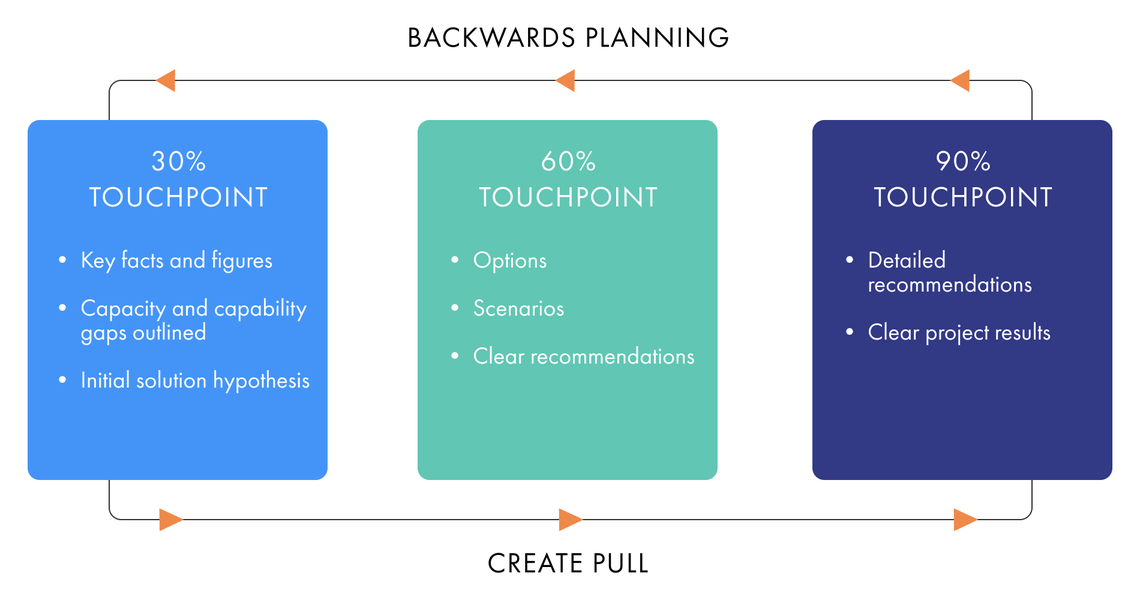While some projects succeed, many do not achieve their full potential. Epic failures are quite rare, but perhaps your vision and ambition somehow fell short.
And now, as the project ends, the best you can hope for is a mixed follow-through and a wave of relief from a team that never quite engaged. And as you put it behind you, accepting the disappointment, you move on to the next thing with your ambition somewhat quelled.
But ambition is precious. It builds better businesses, changes peoples’ lives, and does good in the world. Without ambition there is no innovation, and no growth. Can you imagine a world without the visionaries of Apple, Uber, Amazon? Yet they’ve all had projects that did not go well.
The elements of success
When we think of projects, they often seem simple – a solid project team with a clear project plan. But if it was that easy, we wouldn’t be discussing what went wrong and looking for a new and better way. So, let’s take a moment to reflect. Ask yourself honestly, did you have a vision that perhaps wasn’t shared, an overloaded team that didn’t buy in, a cross-functional project fragmented by silos, or even, expensive external help that dictated how things should be done?
For many of our clients, these root causes resonate. Without intention, the project team was missing the clarity, confidence, and empowerment they needed – the key elements to making your project successful and fun.
Let’s consider how these elements connect:
Figure 1. Six key elements of project management success

VISION + BENEFITS
1. Anchor on clear benefits
Your vision is a big and bold picture of how you want things in your organization to be – the experiences that you deliver for your customers, the joy your employees get from working for you, the patients’ lives that you improve, and the difference you make in the world.
Projects are components of your transformation strategy that bring this vision to life. Like pieces of a jigsaw, in isolation, each piece, each goal, doesn’t look like much.
We find that many projects have relatively broad, generic objectives: Here’s a real-life example, “Better aligned commercial and supply chain functions on product launch.” What’s missing is a clear and quantified statement of benefits – Why is this goal important and what will success bring?
Instead, try this, “A seamless connection between commercial and supply chain functions to launch Product X in 12 weeks, with an 80% customer conversion in 6 months.” Now that’s a statement that can rally the troops and make it clear why this project is important!
You may think that the difference between goals and benefits is largely semantics. But it is surprisingly important and can spell the difference between project success or shortfall. A set of well-defined purpose- and performance-driven benefits will do two things. First, it will evoke a rational reaction, “I can see these are important business objectives and will deliver X, Y, and Z”. Second, it will illicit an emotional response, “It would be really cool to achieve this, my job will be easier and more enjoyable, and I’m excited to be involved”.
During scoping discussions, get your project lead and team together to define the benefits in detail. It’s critical to align different cross-functional stakeholders and reach a set of common goals.
It usually takes a few iterations to land on a crisp and concise statement of benefits. Multiple discussions with different stakeholders raise questions and concerns, but also identify issues, zero in on key points, and get everyone aligned. Don’t rush success planning, the pressure to deliver may be on, but give everyone time to let things sink in. A concrete benefit statement is the foundation for project success and one your teams will understand, believe, and own (UBO).
Anchoring on clear benefits enables your project team to work backwards – reverse engineering to define key deliverables and a comprehensive project plan. Successful projects stem from clarity, a thorough understanding of the outcomes, approach, and resource. Planning for success in this way rallies project leads and teams, and their buy-in means more advocates to champion the change.

OBSTACLES + STRENGTHS
2. Carefully plan your offense and defense
You cannot win the Super Bowl or World Cup if your offense is outstanding but your defense sucks. In every sport, leading coaches strategically plan their offense and defense.
Project management today is largely about offense – you have a goal, the team builds a plan, and off they go. At most, someone keeps a risk log somewhere, but nobody really cares about that. The reality is defense is important. Whether it’s a misaligned key stakeholder or a function that doesn’t provide the right data, a project can quickly veer off track. Different functions might push and pull in different directions and eventually you might just run out of gas.
A detailed in-depth discussion should tackle both obstacles (defense) and strengths (offense). A roadmap of workstreams, deliverables, milestones, and project plans should assign clear responsibilities and due dates. And it should anticipate and prepare to address roadblocks and delays along the way.
A mechanism to have honest conversations about obstacles is a key to unlock project success. The tendency to avoid bad news is only natural. Build trust to empower project teams and leads to proactively flag issues early. And get obstacles on the agenda in governance meetings to enlist sponsor support and mitigate problems in the right way.

BACKWARDS PLANNING
3. Plan backwards to go forwards
In Western cultures, we read and write from left to right and our brains are wired to plan projects the same way. A kick-off, planning, gathering facts and figures, conducting team and stakeholder surveys and interviews... And on it goes! While the concept of backward planning is not new, it is rarely applied.
Take backward planning seriously. A clear statement of benefits is the starting point. Ask yourself, to deliver these benefits in 6 months, what are the key deliverables and milestones in months 5, 4, 3, 2, and 1? How are these deliverables connected? What are the dependencies? How can this all be divided into manageable chunks? And who will do the work? Keep the end goal in mind and work back from right to left. A manageable and achievable set of actions drives confidence in execution and delivery.

CAPACITY + CAPABILITIES
4. Think critically about resources and stakeholders
You bring in a trusted colleague as your project lead and take their guidance on the project team. A steering committee of key executives rounds off the project management organization (PMO) and it would seem everything is set. But then reality hits home as you kick-off, your met by a lack of excitement by the individuals nominated and involved. Naturally, they are your high performers already supporting multiple projects elsewhere. At best, they have a few hours of capacity to spare per week, if any at all.
Before project kick-off, have an honest and in-depth discussion with key stakeholders and your proposed project lead about resourcing and the potential options. Align on the critical skills and capabilities needed and explore who could be involved and how much time they can invest.
Avoid the internal/external trap. Too often, companies see these as distinct options – undertake the project internally or outsource it to a consulting firm. There are benefits in both. Your internal teams understand your business and the inner ways of working and a consulting firm brings expertise and proven methodologies that fill capability gaps.
An agile, hybrid project model can prove highly effective and cost efficient. It keeps your team in the driving seat for internal ownership, with the flexibility to scale resource up and down as needed. Work through all the options and scenarios. A small team that can spend two days a week on this project, or a large team that can only spend two hours a week – what does this mean in terms of capacity, capabilities, and commitment, and where might external support help?
Projects develop your team’s capabilities and skillsets. Having internal team members closely work alongside external consultants can be a great motivator and learning opportunity and help you eventually phase out support.

PROJECT TIME HORIZON
5. Create pull with the 90/60/30 rule
Whether your project is to define a strategy or implement it, your project time horizon should be long enough for the team to develop recommendations and new solutions. But it should not be too long that it’s difficult to plan, foresee new learnings, or consider general changes in the environment. For larger projects, it’s helpful to break them down into shorter phases with key milestones.
In the spirit of backward planning, consider driving momentum with the 90/60/30 rule, figure 2. Schedule key touchpoints for the project team to report back to the steering committee and sponsors at the start of every project or phase.
Figure 2. 90/60/30 touchpoint structure

It may be an oversimplification, but for many projects the general rule applies:
90% steering committee
If you are planning a 12-week project, this should be scheduled 11 weeks in. Detailed recommendations and project results should be quite clear by then, alongside an implementation plan of what’s to come. This gives the team a further week to wrap up and answer any open questions that remain.
60% steering committee
About 7 or 8 weeks into the project, you will want the team to report back with a high-level recommendation, or to present a few options for the steering committee to make decisions on.
30% steering committee
Planning further backwards, about 3 or 4 weeks in, the team should report back on initial fact finding and present some initial “solution hypotheses”.
This critical element of backward planning creates the ‘pull’ to move the project along. It enables the project lead to assign key tasks and empowers team members to align and present their progress, findings, and ideas to senior teams. And whether your project is long (6-12 months) or short (3-4 weeks) the 90/60/30 rule still applies.

EMBED CHANGE
6. Embed success in heart and mind
Continue to share your ambition to deepen understanding of how projects benefit the business and team, and how everyone has a role to play to make the vision real.
Shift your projects away from being a burden to an opportunity for your team. The responsibilities come on top of the existing day job, and the benefits should be well defined. And remember the emotional response. Projects should be designed to improve the employee experience and align with people’s development goals.
If you don’t engage both hearts and minds, you could face difficult disagreements and discord. But get it right and project participants will have fun, enjoy the experience, and feel like they learned a lot. And though they may be sad when the project comes to an end, they’ll be more than ready for the next one to begin.
Before project execution kick off, apply these six elements with conviction and rigor to achieve project success. They are a fundamental part of every project we partner on and what we call The Genioo Way.
Still need convincing?
Andreas Egli, Head of Client Services Europe, explores examples of project success
Find out more


